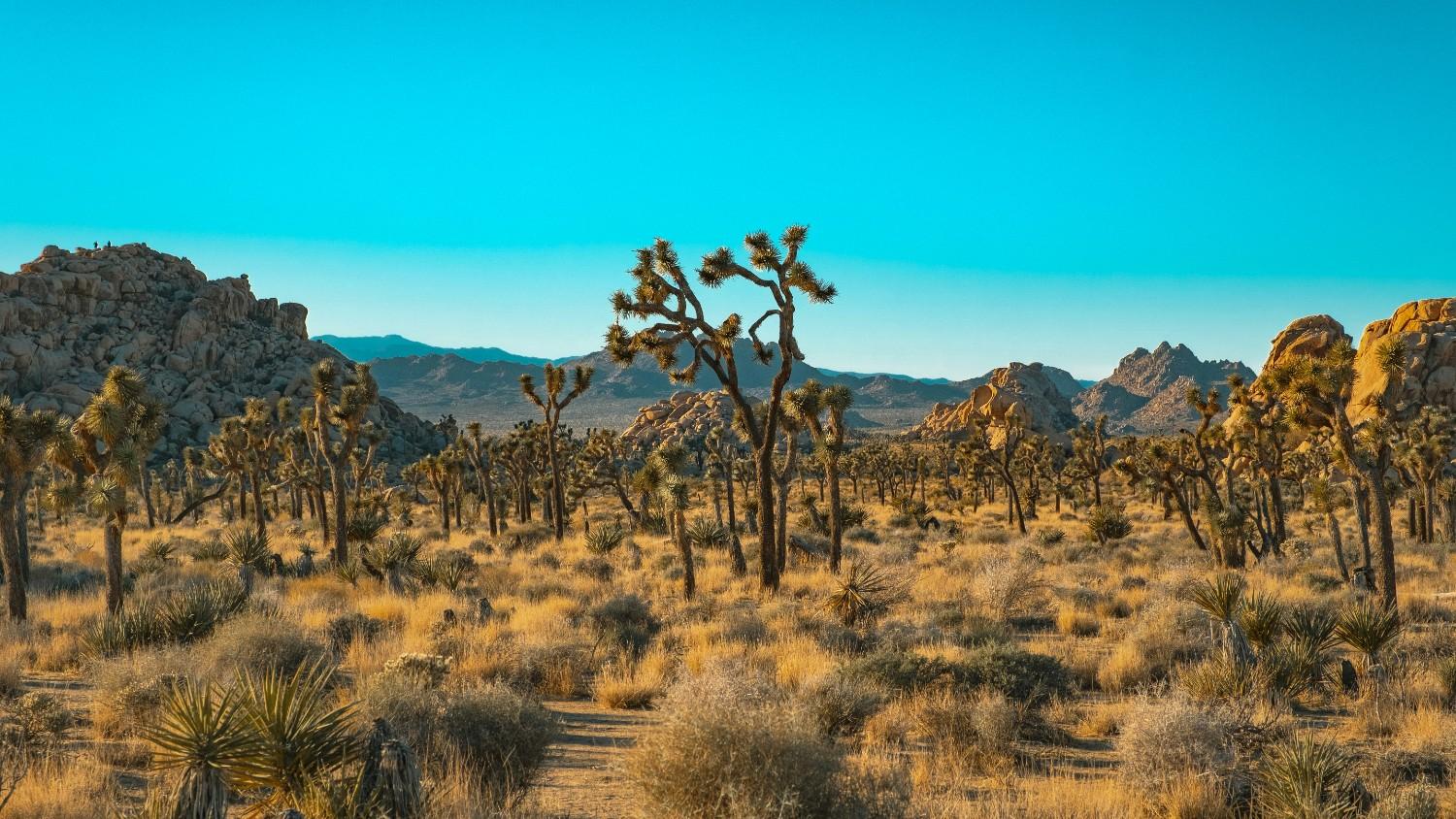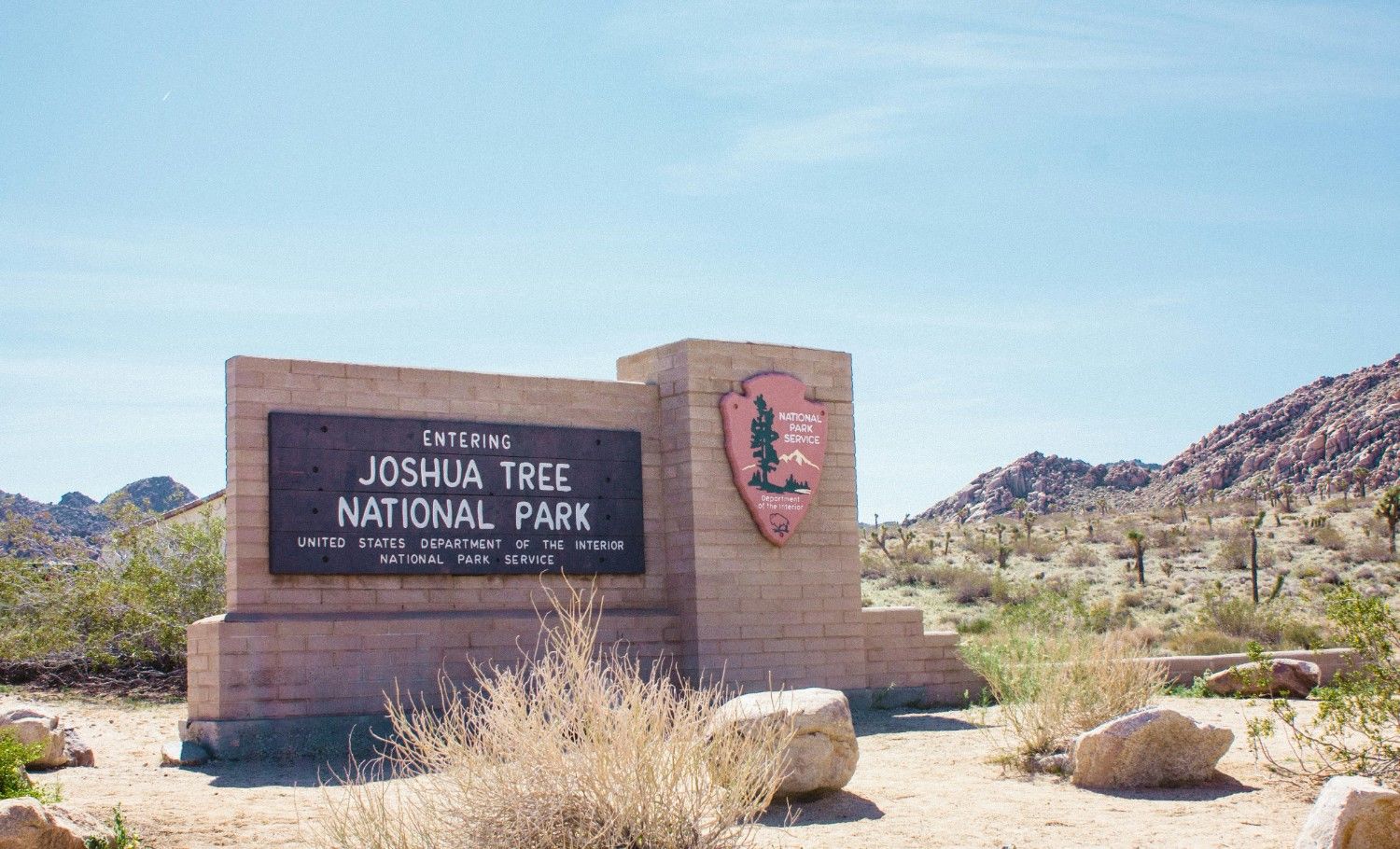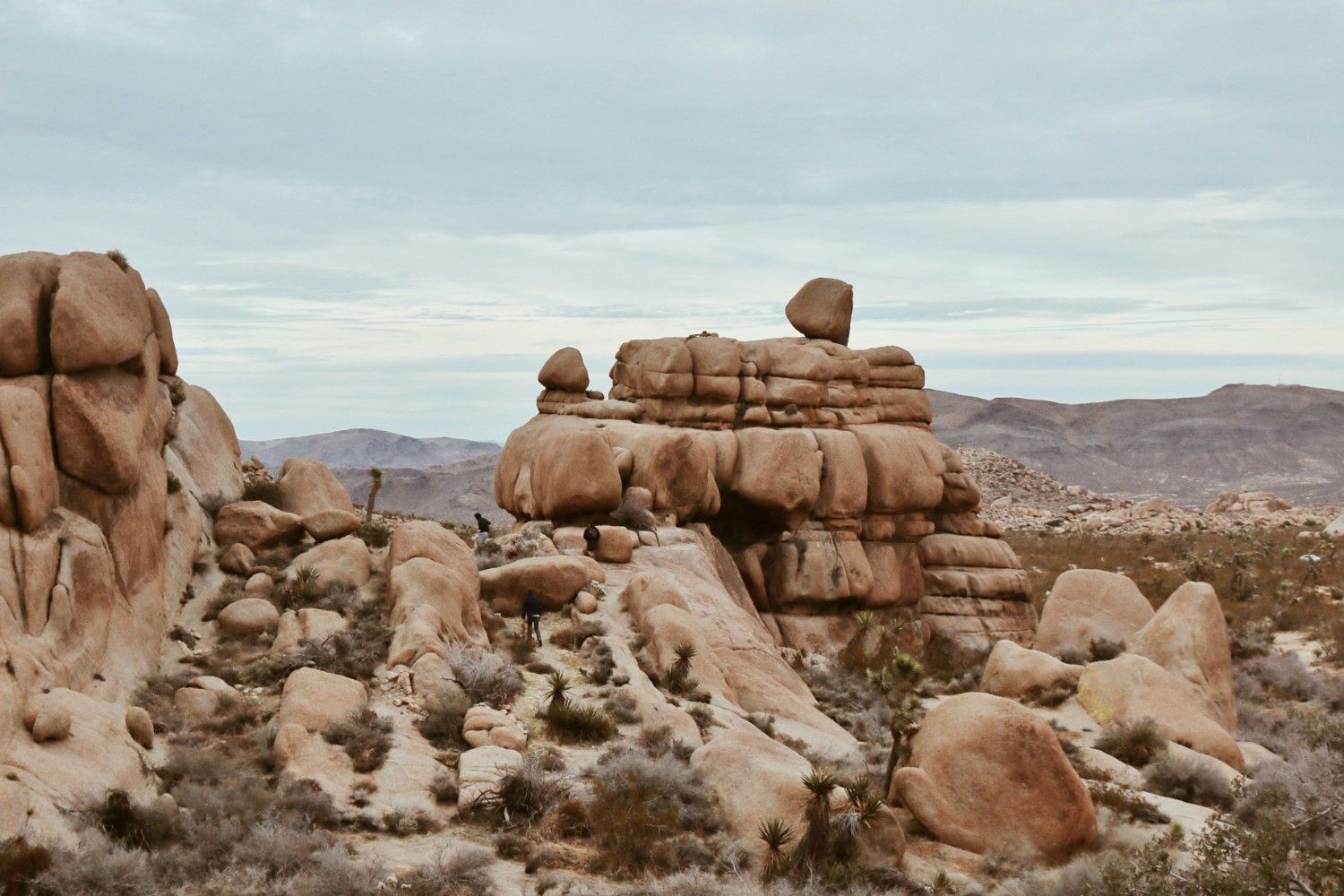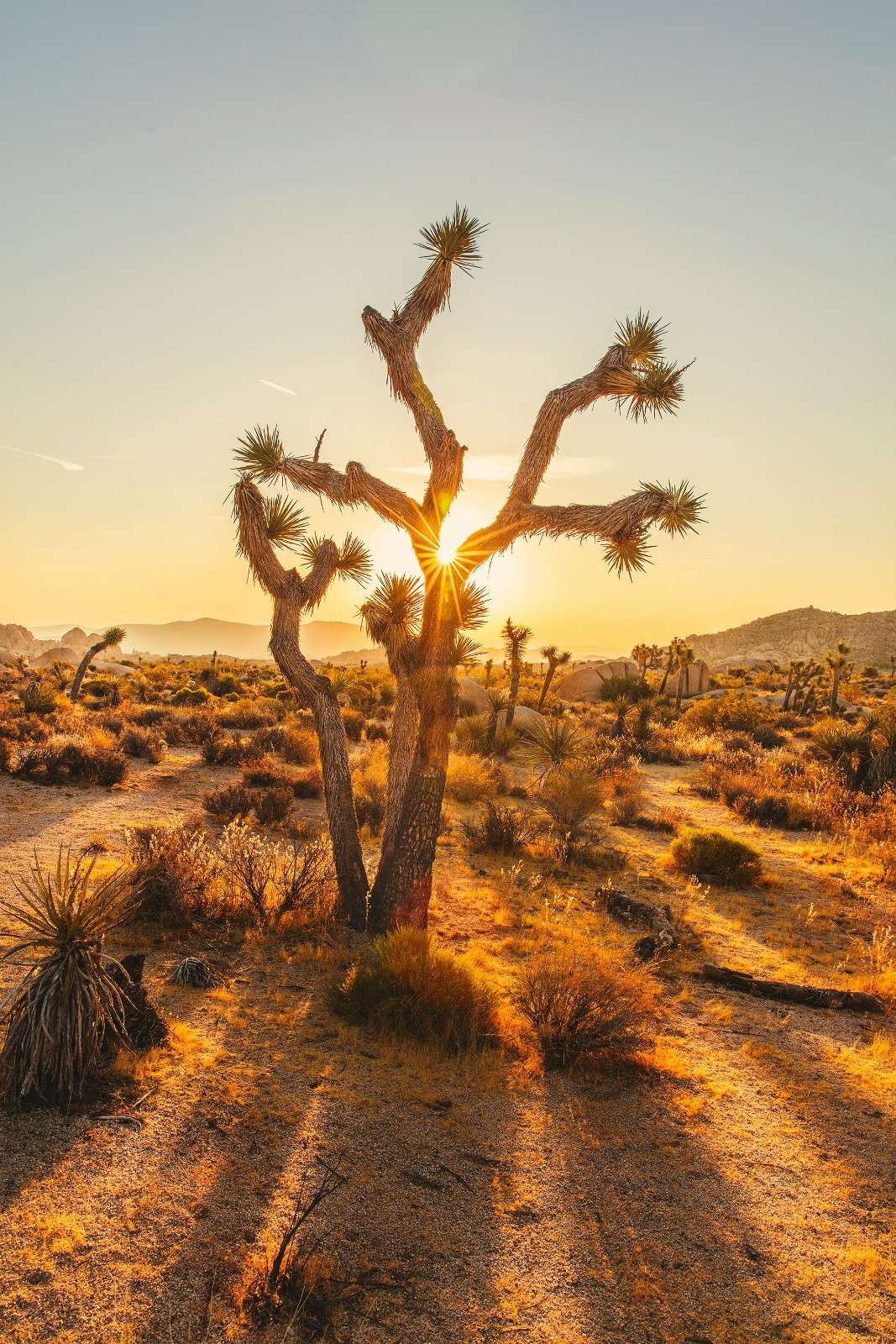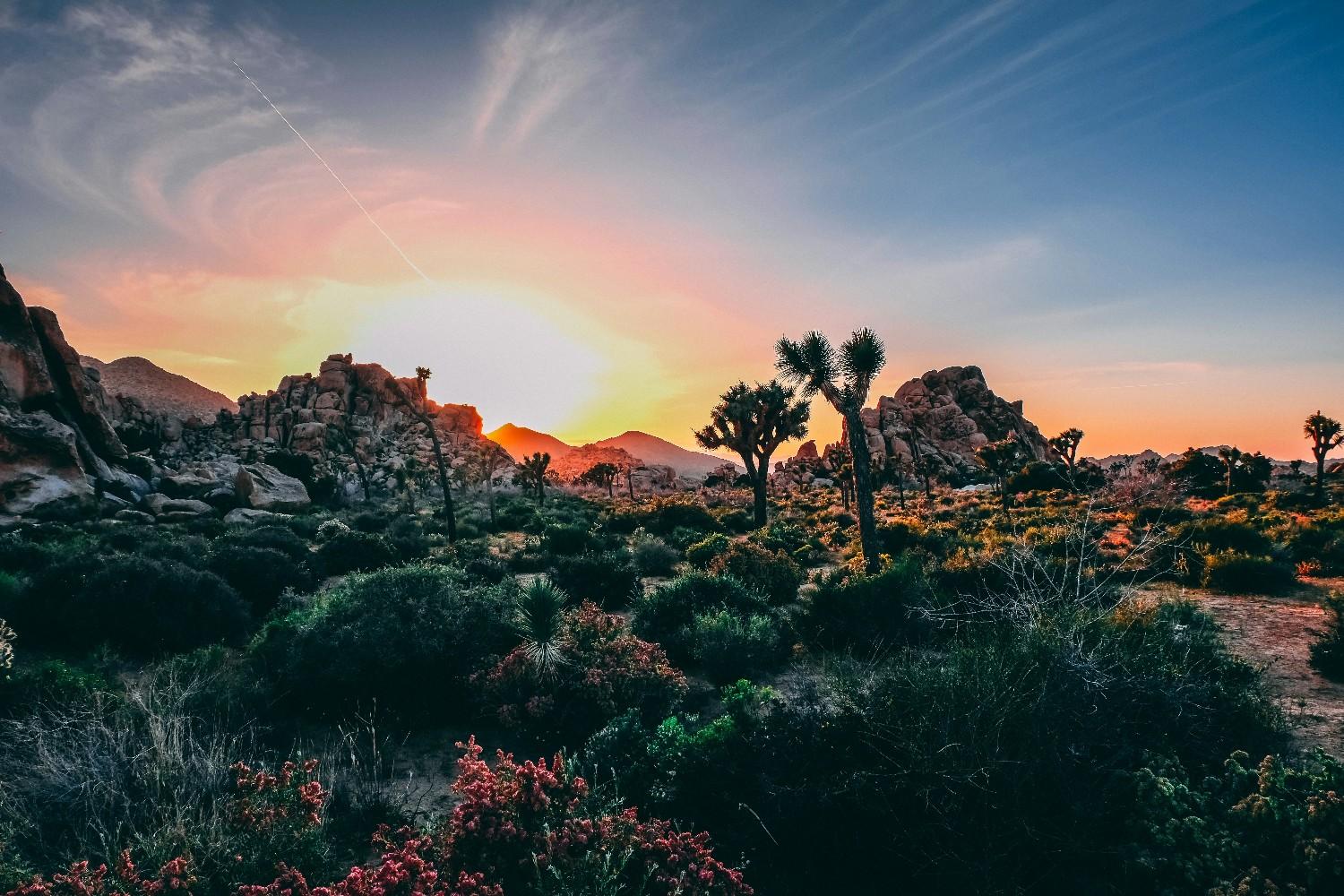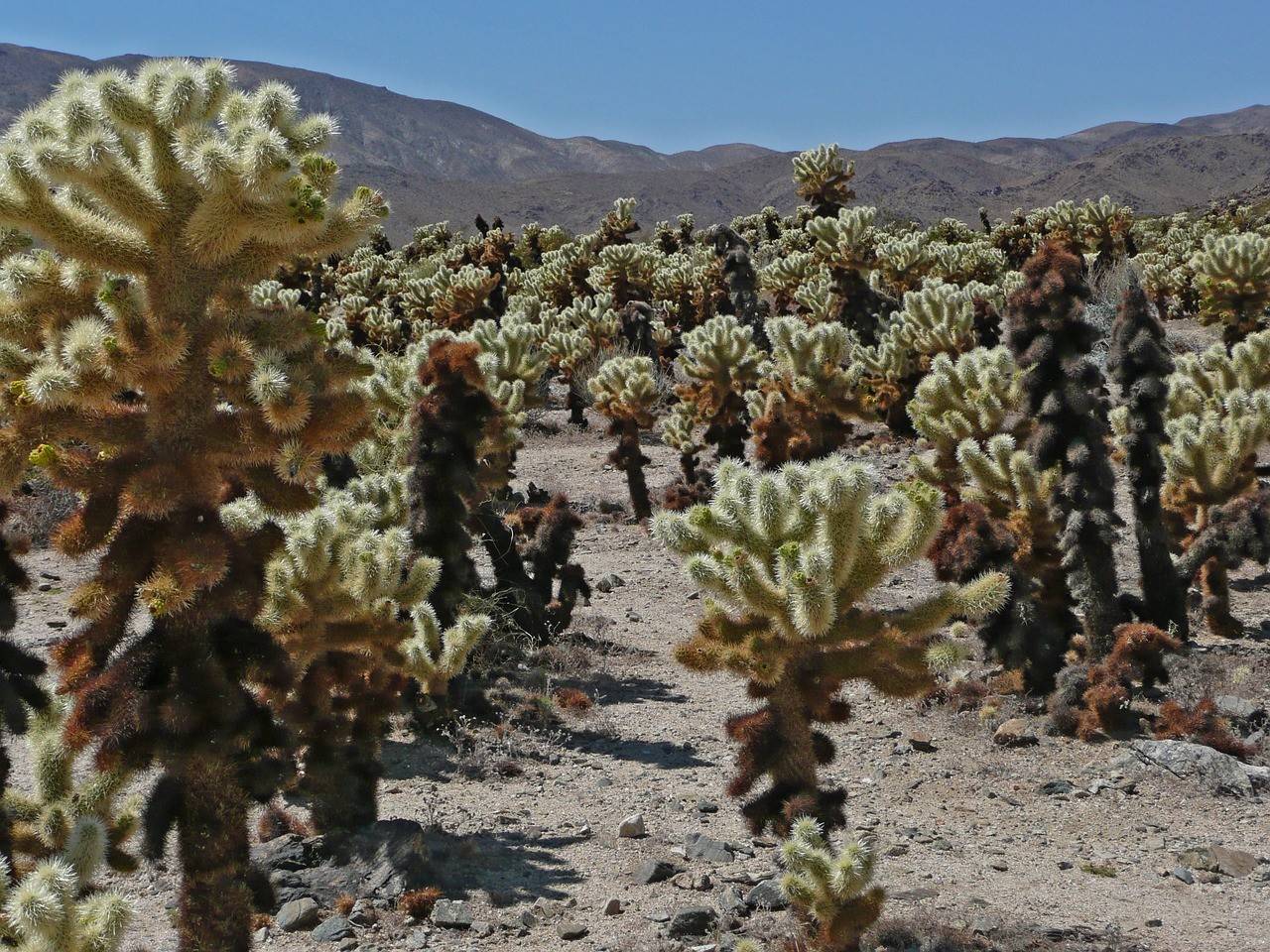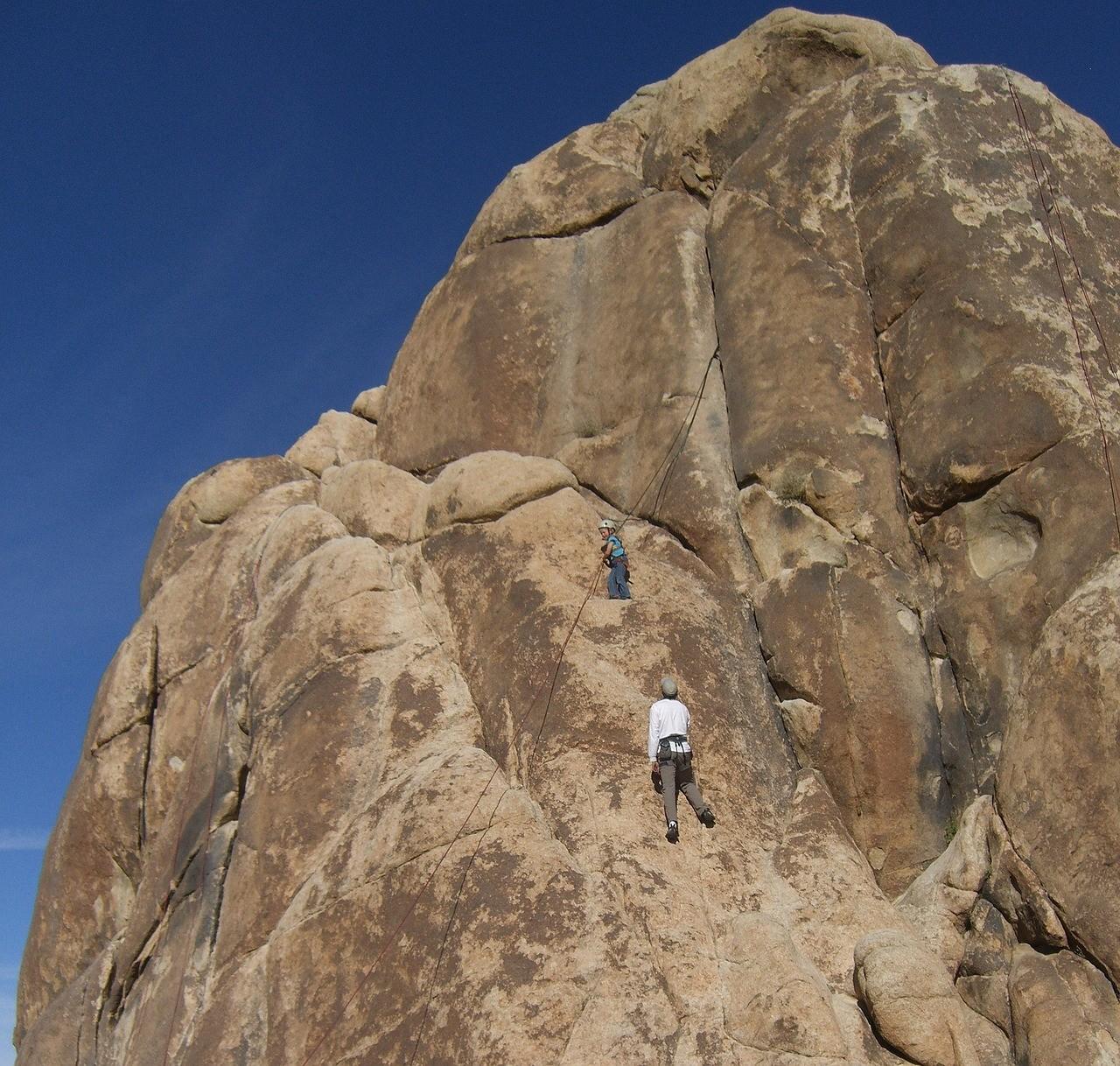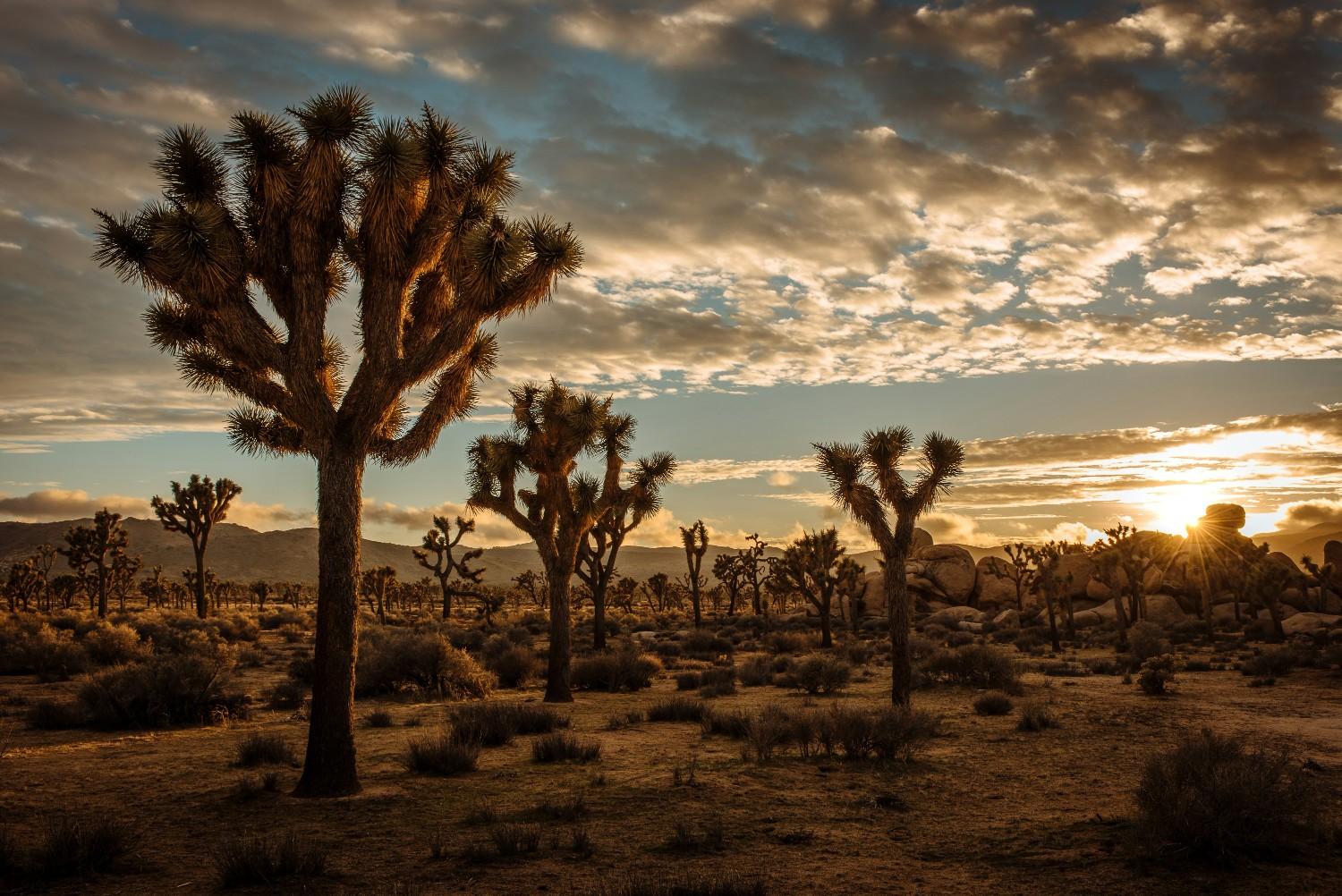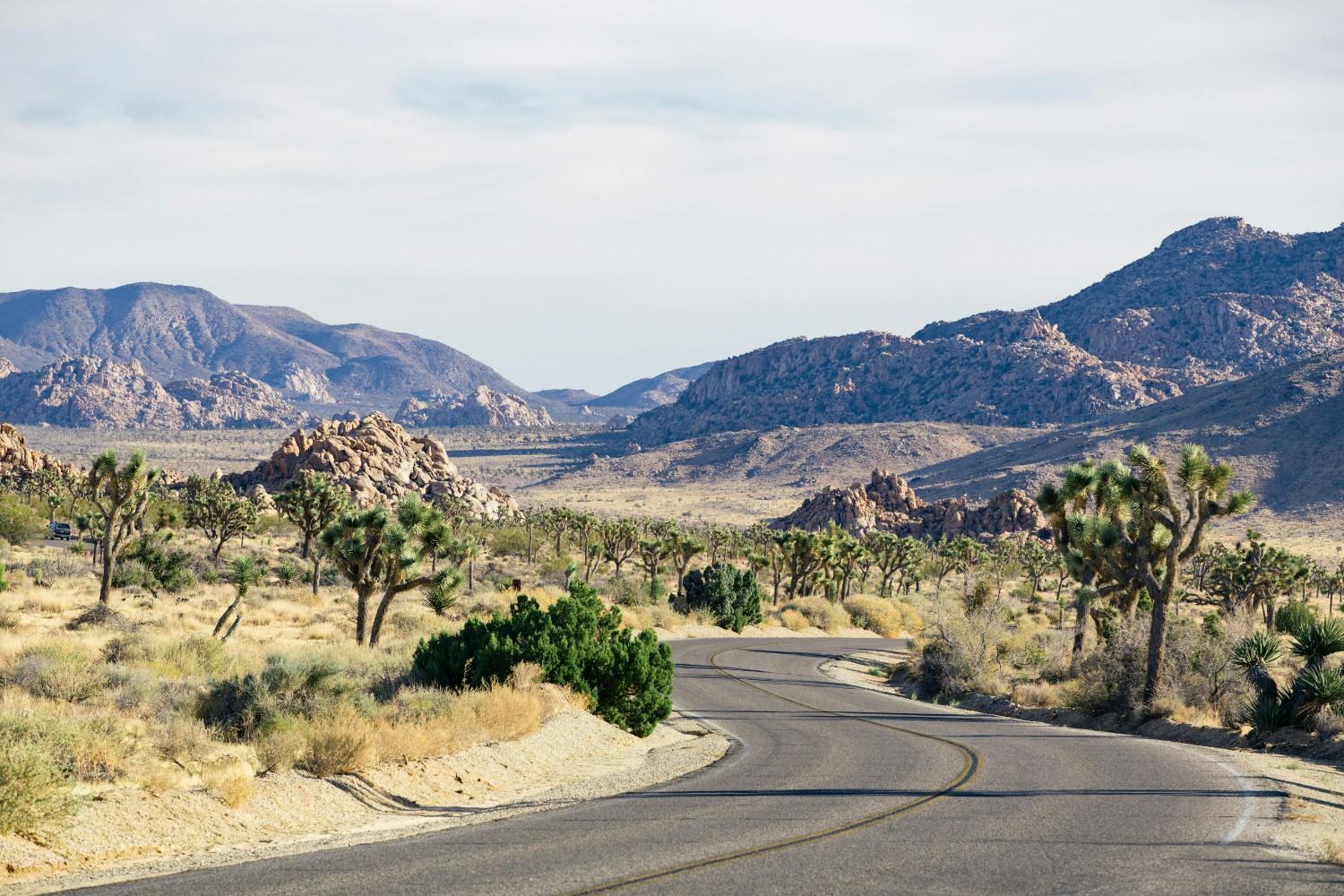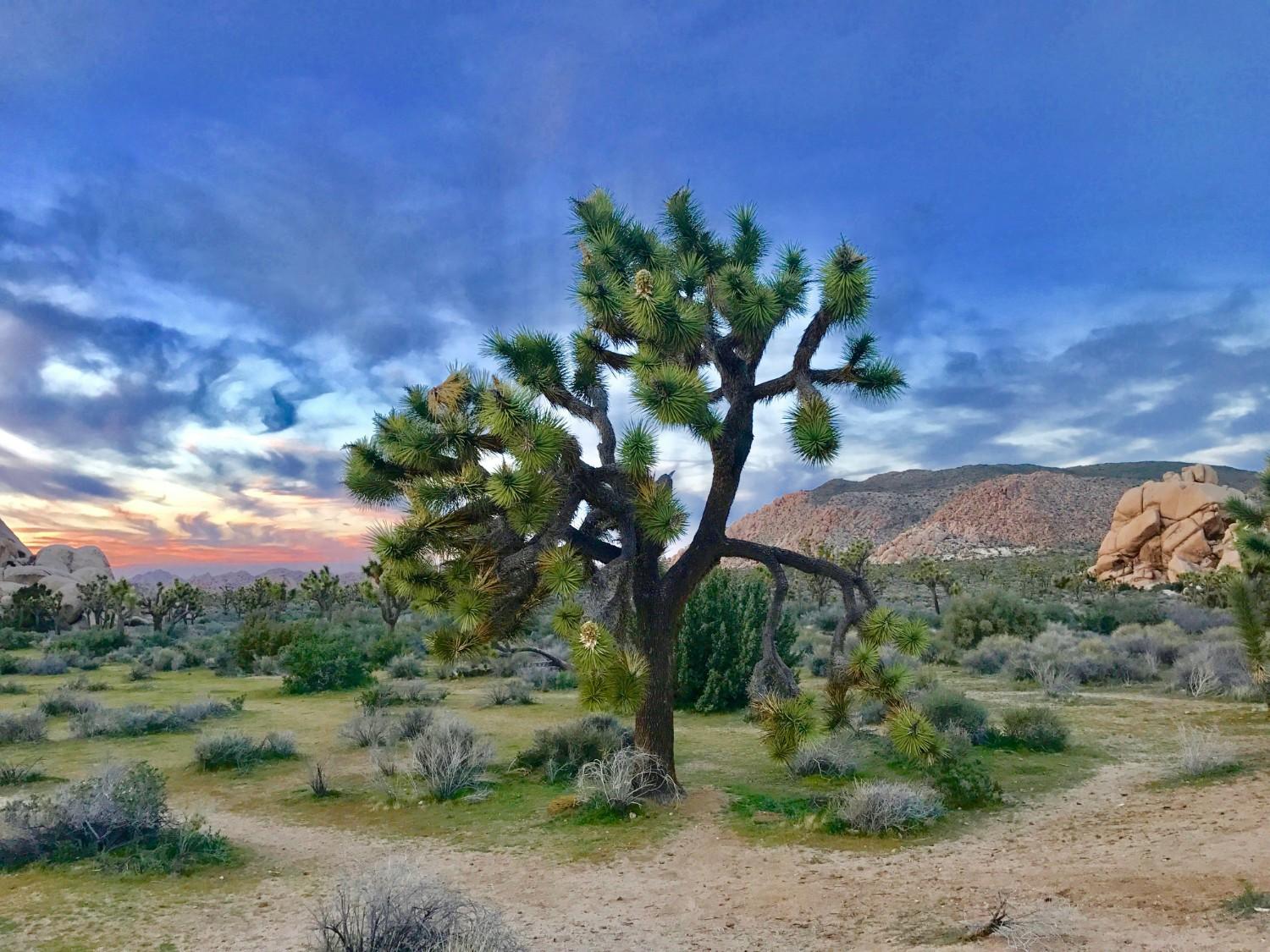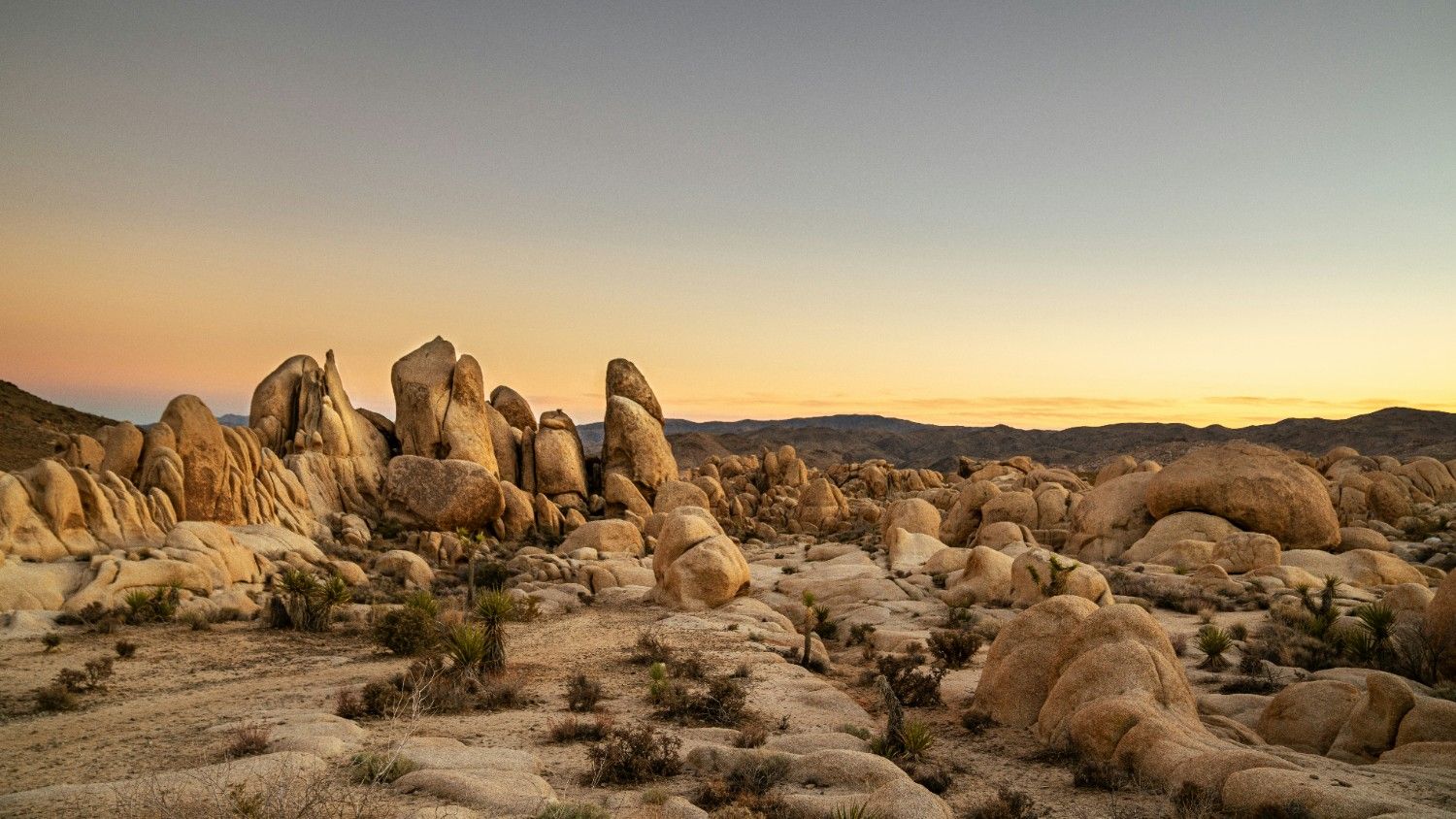Nestled within the heart of California's Mojave and Colorado Deserts lies Joshua Tree National Park, a captivating realm where nature's artistry takes centre stage. This extraordinary expanse of rugged landscapes and striking geological formations beckons adventurers and nature lovers alike to embark on an unforgettable journey. With its distinctive Joshua trees, towering rock formations, and boundless desert vistas, this national park offers a truly otherworldly experience. The park's unique ecosystem, shaped by millions of years of geological upheaval, has given rise to a tapestry of surreal rock sculptures and vibrant desert flora. You will encounter twisted and gnarled Joshua trees, their spiky arms reaching skyward like sentinels guarding the desert's secrets. Whether you're a seasoned hiker, a rock climber seeking new challenges, or simply a nature enthusiast in search of awe-inspiring vistas, Joshua Tree National Park promises an extraordinary adventure. Prepare to be captivated by the park's raw beauty, rich cultural heritage, and boundless opportunities for exploration and discovery.
A Geological Masterpiece — Rock Formations and Desert Landscapes
Joshua Tree National Park is a true geological masterpiece, a canvas upon which nature has painted its most stunning creations. The park's two distinct ecosystems, the Mojave and Colorado Deserts, converge to form a landscape that is as diverse as it is awe-inspiring.
The Wonderland of Rocks – A Labyrinth of Stone Sculptures
At the heart of Joshua Tree National Park lies the Wonderland of Rocks, a mesmerising labyrinth of massive boulders and towering monoliths that seem to defy the laws of gravity. This geological masterpiece is a true highlight of the park, offering a surreal and otherworldly experience that captivates the senses and ignites the imagination. There is a symphony of shapes and textures - massive boulders, some the size of small buildings, are precariously balanced atop one another, creating a playground for adventurers and photographers alike. Squeeze through narrow passages and explore hidden canyons, where the play of light and shadow transforms the rocks into an ever-changing tapestry of hues and patterns.
The Wonderland of Rocks is not merely a collection of stone sculptures; it is a living testament to the incredible power of nature's forces. Over millions of years, the relentless forces of wind, water, and time have sculpted these formations, carving intricate details and leaving behind a landscape that seems almost too fantastical to be real. For rock climbers, the Wonderland of Rocks offers a veritable playground of challenges and adventures. Towering granite monoliths and intricately featured rock faces beckon climbers to scale their heights, offering a unique opportunity to intimately connect with the park's geological marvels.
The Striking Silhouettes of Desert Flora
While the rugged rock formations of Joshua Tree National Park steal the spotlight, the park's desert flora adds a vibrant and captivating counterpoint to the stark landscapes. The park's namesake, the Joshua tree, is undoubtedly the most iconic of these desert dwellers. With their twisted and gnarled branches reaching skyward, these remarkable plants seem to defy the arid conditions, standing as silent sentinels over the desert. Their unique silhouettes, often likened to stretching arms or frozen dancers, have captured the imaginations of artists and photographers for decades.
Complementing the Joshua trees are a myriad of other desert flora, each with its unique adaptations and stunning forms. The delicate desert wildflowers that carpet the ground after seasonal rains offer a fleeting burst of colour, their resilience a testament to the enduring beauty of these arid lands. Meanwhile, the hardy cacti and succulents, with their prickly exteriors and fleshy interiors, dot the landscape like sentries, their vibrant hues and intricate patterns adding depth and texture to the desert tapestry. There is a remarkable array of plant life, from the stately ocotillo, with its crimson-tipped wands, to the graceful California fan palm, its fronds swaying gently in the desert breeze. Each plant tells a story of adaptation, resilience, and the incredible power of nature to thrive in even the most extreme environments.
Geological Forces at Play — Sculpting the Desert
Joshua Tree National Park is a living testament to the power of geological forces that have shaped and sculpted the Earth's surface over millions of years. Here, the intricate interplay of wind, water, and time has created a landscape that is both rugged and breathtakingly beautiful, a canvas upon which nature has painted its most striking masterpieces. As you explore the park's diverse terrain, you'll witness firsthand the effects of erosion on the rock formations, with wind and water carving intricate patterns and textures into the stone. Vast alluvial fans, formed by the deposition of sediment from ancient rivers, stretch out like frozen waves across the desert floor, their undulating ridges and valleys a testament to the power of flowing water. Towering monoliths and rock spires stand as sentinels, defying the relentless forces of nature that have sculpted their surroundings. These geological wonders offer a glimpse into the Earth's history, revealing layers of time and the incredible forces that have shaped our planet over aeons.
Beyond the visual spectacle, the park's geology also offers a fascinating window into the processes that have shaped the Mojave and Colorado Deserts. The uplift and erosion of ancient mountains, the deposition of sedimentary rocks, and the intrusion of molten magma have all played a role in creating the diverse landscapes. From the towering rock formations to the intricate patterns etched into the desert floor, Joshua Tree National Park is a living museum of Earth's geological history, a testament to the enduring beauty and complexity of our planet.
The Convergence of Deserts — Mojave and Colorado
Joshua Tree National Park is a unique convergence of two distinct desert ecosystems: the Mojave and the Colorado Deserts. This convergence creates a tapestry of landscapes that are as diverse as they are captivating, each with its unique character and array of flora and fauna. The Mojave Desert, which dominates the park's northern and western regions, is characterised by its vast expanses of dunes, rugged rock formations, and the iconic Joshua trees. The Mojave is a land of extremes, where scorching summer days give way to chilly nights, and where the scarcity of water has shaped a unique ecosystem of hardy plants and animals adapted to survive in this arid environment.
In contrast, the Colorado Desert, which encompasses the park's southern and eastern sections, offers a more lush and vibrant experience. Dotted with palm oases and fed by underground springs, this desert environment supports a greater diversity of plant and animal life, including the striking ocotillo and the iconic California fan palm. The Colorado Desert is a study in contrasts, where lush green oases give way to expansive stretches of desert floor, and where the presence of water has nurtured a rich tapestry of life.
A Hiker's Paradise — Trails and Outdoor Adventures
For outdoor enthusiasts and adventure seekers, Joshua Tree National Park presents a veritable playground of hiking trails, rock climbing routes, and opportunities for exploration. Whether you're seeking a stroll or a challenging multi-day trek, the park's trail system caters to hikers of all skill levels.
Iconic Hiking Trails —Exploring the Park's Diverse Terrain
Joshua Tree National Park is a hiker's paradise, offering a diverse array of trails that cater to adventurers of all skill levels. From strolls to multi-day treks, the park's extensive trail system provides ample opportunities to immerse yourself in the park's stunning landscapes and witness the beauty of the desert up close. One of the park's most iconic hikes is the Ryan Mountain Trail. This 3-mile round-trip journey rewards intrepid hikers with panoramic vistas of the park's striking rock formations and vast desert expanses. The landscape is dotted with Joshua trees and towering boulders, culminating in a breathtaking viewpoint atop Ryan Mountain. The Boy Scout Trail, a strenuous 16-mile loop, offers a true wilderness experience. This epic hike takes you through remote canyons, past ancient rock art sites, and across vast stretches of desert, providing a sense of solitude and immersion in nature that is truly unparalleled.
Hidden Gems — Uncovering the Park's Secret Wonders
While the park's major trails are undoubtedly spectacular, Joshua Tree National Park also harbours a wealth of hidden gems that can only be discovered by venturing off the beaten path. These lesser-known trails and routes offer a sense of solitude and adventure that is hard to find elsewhere. One such hidden gem is the Lost Horse Mine Trail, a moderate 6.5-mile loop that takes you through a secluded canyon adorned with towering rock faces and scenic overlooks. Along the way, you'll have the opportunity to explore remnants of an old gold mine, offering a glimpse into the park's rich history and the perseverance of those who sought fortune in these rugged lands. Another hidden gem is the Mastodon Peak Loop, a strenuous 7-mile hike that rewards hikers with breathtaking vistas of the park's iconic rock formations, including the striking Mastodon Peak itself. This challenging trail is not for the faint of heart, but it promises an unforgettable adventure for those willing to tackle its steep ascents and rocky terrain.
Rock Climbing Adventures — Scaling New Heights
For those seeking a truly unique and exhilarating outdoor adventure, Joshua Tree National Park is a mecca for rock climbing enthusiasts. With its abundance of world-class climbing routes and striking rock formations, the park offers a playground for climbers of all skill levels, from beginners to seasoned veterans. The Wonderland of Rocks, with its towering granite monoliths and intricate rock features, is a particular highlight for climbers. There is a diverse array of routes ranging from beginner-friendly top-ropes to challenging multi-pitch adventures that will test your skills and push your limits. The sheer variety of rock formations, coupled with the park's stunning desert landscapes, create an unparalleled climbing experience that is both physically and visually rewarding.
For those new to the sport, Joshua Tree National Park is an excellent place to learn and hone your skills. The park's climbing guides and instructors offer comprehensive instruction and guided climbing experiences, ensuring a safe and unforgettable introduction to this exhilarating outdoor pursuit. With their expert guidance and support, you'll learn the fundamentals of rock climbing, from proper technique and safety measures to route-finding and equipment management. As you progress in your climbing journey, the park's more advanced routes will beckon, offering a wealth of challenges and rewards. Climb iconic formations like Intersection Rock, a striking monolith that offers a range of routes for climbers of varying abilities, or test your mettle on the towering walls of Lost Horse Wall. Beyond the physical challenges of rock climbing, the sport also offers a unique opportunity to connect with the natural world profoundly and intimately.
Stargazing and Night Adventures — Embracing the Darkness
As the sun dips below the horizon, Joshua Tree National Park takes on a whole new allure, transforming into a celestial playground for stargazers and night adventurers alike. With its vast expanses of dark skies and minimal light pollution, the park offers unparalleled opportunities to witness the magnificence of the Milky Way and other celestial wonders.
Guided night hikes and stargazing programs, led by knowledgeable park rangers and astronomers, provide an immersive experience, allowing you to explore the park's nocturnal landscapes while learning about the constellations, celestial phenomena, and the park's rich cultural history related to the night sky. As you traverse the desert trails under the glow of the moon and stars, you'll gain a deeper appreciation for the intricate tapestry of the cosmos and the profound connection between humanity and the universe. As the night deepens, the desert comes alive with a symphony of sounds and movements. The haunting howls of coyotes echo across the landscape, while the scurrying of nocturnal creatures punctuates the stillness. Beyond the stargazing and wildlife encounters, the park's night adventures also offer a unique opportunity for self-reflection and introspection. It is in these moments of stillness and solitude that a true connection with nature is born, fostering a deeper sense of appreciation and reverence for the wonders that surround us.
Preserving a Natural and Cultural Legacy
Joshua Tree National Park is not merely a stunning natural wonder; it is also a repository of rich cultural heritage and a testament to the resilience of the human spirit. Long before the park's establishment, these lands were home to the Cahuilla, Chemehuevi, and Serrano indigenous peoples, who left their mark through rock art, archaeological sites, and a deep reverence for the land.
Guardians of the Desert — Indigenous Peoples and Their Imprint
Long before Joshua Tree National Park was established, these lands were home to the Cahuilla, Chemehuevi, and Serrano indigenous peoples, whose deep reverence for the land and intimate connection with nature left an indelible mark on the desert landscape. As you explore the park, you'll encounter numerous reminders of their presence and the rich cultural heritage they have bestowed upon these lands. One of the most striking legacies of these ancient civilisations is the abundance of petroglyphs and rock art that adorn the canyon walls and boulders throughout the park. These intricate carvings and paintings offer a fascinating glimpse into the beliefs, traditions, and daily lives of the park's original inhabitants, serving as a powerful reminder of the enduring human connection to the natural world. You'll also encounter ancient grinding holes, pottery shards, and other archaeological sites that bear witness to the ingenuity and resilience of these desert dwellers.
Conservation Efforts — Protecting the Desert Ecosystems
Joshua Tree National Park is a repository of cultural heritage and a vital sanctuary for the delicate ecosystems of the Mojave and Colorado Deserts. As the impacts of human activity and climate change continue to threaten these fragile environments, the park's conservation efforts have become increasingly crucial in preserving the unique flora and fauna that call these deserts home. Through ongoing research, monitoring, and habitat restoration initiatives, the park's dedicated team of biologists, ecologists, and land managers work tirelessly to safeguard the park's diverse array of plant and animal species. From protecting endangered species like the desert tortoise to preserving critical habitats for migratory birds, the park's conservation efforts span a wide range of initiatives.
The park also places a strong emphasis on education and public outreach, fostering a deeper understanding and appreciation for the desert ecosystems among visitors and the local community. Through interpretive programs, guided hikes, and educational exhibits, the park seeks to inspire a sense of stewardship and responsibility for these unique and fragile environments.
Sustainable Tourism — Minimising Our Footprint
As the popularity of Joshua Tree National Park continues to grow, the challenge of balancing conservation efforts with the influx of visitors becomes ever more pressing. To address this challenge, the park has embraced the principles of sustainable tourism, implementing strategies and practices that aim to minimise the environmental impact of human visitation while enhancing the visitor experience. One of the key initiatives in this effort is the promotion of Leave No Trace principles, which encourage visitors to minimise their impact on the park by practising responsible recreation. This includes carrying out all trash, staying on designated trails, and respecting the park's delicate ecosystems by avoiding activities that could cause harm or disturbance.
The park also emphasises the importance of responsible camping and backcountry exploration, providing guidelines and regulations that help protect fragile desert environments while still allowing visitors to experience the beauty and solitude of the park's remote areas. By embracing sustainable tourism practices, Joshua Tree National Park aims to strike a delicate balance between preserving the natural and cultural heritage of the park and providing opportunities for visitors to experience and appreciate this remarkable desert oasis.
Partnerships and Community Engagement — A Collaborative Effort
Preserving the natural and cultural legacy of Joshua Tree National Park is a collaborative effort that extends far beyond the park's boundaries. The park has fostered strong partnerships with local communities, indigenous tribes, environmental organisations, and academic institutions, all working together towards a common goal of protecting and celebrating this unique desert landscape. Through these partnerships, the park has been able to expand its reach and impact, engaging in collaborative research projects, educational outreach programs, and community-based conservation initiatives. By involving stakeholders from diverse backgrounds and perspectives, the park ensures that its efforts are informed by a wide range of knowledge and experiences, enhancing the effectiveness and inclusivity of its preservation efforts.
One notable example of these partnerships is the park's collaboration with local indigenous tribes, who share their traditional ecological knowledge and cultural perspectives, helping to shape the park's interpretation and management strategies. By incorporating these insights, the park not only honours the deep-rooted connections between the land and its original inhabitants but also fosters a more holistic and culturally sensitive approach to conservation. By embracing a spirit of collaboration and community engagement, the park ensures that its legacy will endure for generations to come.
Related articles

Let us know you agree to cookies
We use marketing, analytical and functional cookies as well as similar technologies to give you the best experience. Third parties, including social media platforms, often place tracking cookies on our site to show you personalised adverts outside of our website.
We store your cookie preferences for two years and you can edit your preferences via ‘manage cookies’ or through the cookie policy at the bottom of every page. For more information, please see our cookie policy.
